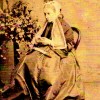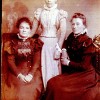If there is one industry that could be singled out as almost a Dorset speciality, it would be the manufacture of buttons for clothing. In the days before the industrial revolution buttony was a thriving means of earning a crust for many rural dwellers, but once there was machinery available for making buttons, the industry moved from a cottage to factory and from south to north. Yet at the peak of the industry in Dorset over 100 different types of buttons were being made, marketed and shipped abroad.
Buttons were not made in England before the 15th century; until then all clothing had been fastened using just a tie-string. It took a man who began his career as a soldier from the Cotswolds to make his adopted county a renowned centre for button-making, though he was not the first buttoner in Wessex. But it was more than knowledge of continental culture that Abraham Case picked up during his years in the Army when stationed in France and Belgium. Case was deeply impressed by the skill and high standard of the buttoner’s art in those countries and after leaving the army he settled in Shaftesbury in 1622 where he soon went about setting up his own buttony business.
From this small beginning buttony had virtually become the foremost Dorset industry by the beginning of the 18th century. It came to employ thousands of women and children and was worth £12,000 a year. Buttons were exported from Liverpool to Europe and America, where they were in great demand.
But Case lived in the days before corporate automation. Within and from Shaftesbury the industry was devolved to many outworkers, mainly women but also some men and children living in cottages. Some villages as well as larger towns became centres with depots provided for the buttoner’s finished goods. Following Shaftesbury’s lead, Blandford, Bere Regis, Lytchett Minster, Iwerne Minster, Langton Matravers and Poole all became significant centres for the industry in its initial phase.
The earliest buttons produced by Case at Shaftesbury were mainly of two types called “High Tops” and “Knobs” made from the horn of Dorset rams. A disc of horn was covered with a piece of linen then worked all over with fine linen thread, creating a conical knob shape depending on the button style required. High tops were used as the buttons for gent’s waistcoats. It is appropriate to indicate at this point that that icon of Dorset, the sheep, not only provided the wool for woollen garments but also the backing material for the “roundels” invented to fasten them with!
A broad variety of button styles, including high tops and knobs were made in east Dorset, as well as those produced in a sire-ring: Blandford Cartwheels, Ten-Spoke Yarrels; Basket Weave; Honeycomb; Cross Wheel of Spiders Web; Jaml or Gem; Spangles; Birds Eye and Mites. Mites and Spangles were very small and bore some beadwork. The Singleton was a black button made from the fine linen-covered padded ring produced exclusively by Case’s widow only between 1658 and 1682.
The finished buttons were then mounted onto cards for sale. “A-1” quality buttons were mounted onto pink cards and reserved exclusively for export. “Seconds” were put onto dark blue cards while those of the poorest quality of all were fastened to yellow cards. All buttons other than those of the finest quality were reserved for the domestic market. Any dirty buttons were boiled in a linen bag before mounting.
Outworkers would take finished buttons to be exported to their local depot on designated “button days” where they could sometimes be paid by barter rather than in cash. It was said that skilled master buttoners could make up to 144 buttons in a batch for which they could be paid 3s 9d (it was 3s 6d for poorer quality buttons.)
When Abraham Cash died the business was taken over by his sons Abraham Jr and Elias. The younger son Elias relocated to Bere Regis where he established the branch industry there and in 1731 engaged john Clayton to re-organise the production. On Clayton’s recommendation an office was established in London in 1743 to manage sales and marketing. The following year the depot at Lytchett Minster was opened. Third generation Peter Case set up depots at Milbourne Stines, Sixpenny Handley, Piddletrenthide, Langton and Wool. By the beginning of the 19th century there were depots for the cottage outworkers in all centres of the industry. Children were employed in the main depots at Shaftesbury and Bere Regis to prepare material for the outworkers.
During the reign of George II, Case’s grandson took the process a stage further with the development of the wire-ring button. The wire was brought in one-and-a-half ton bales by horse-drawn wagon from a factory in Birmingham. This wire would then be made into button rings by being twisted in a spindle before dipping the cut ends in solder. Children were employed to thread the rings onto gross bundles or to polish the finished buttons. The latter procedure had to be stopped when it was realised that the polishing was damaging the thread. At Blandford linen shirt buttons were made as well as the native style called the Blandford Cartwheel. The town’s earlier Huguenot lace industry was by then in decline, but the button makers soon found a new use for the fine lace thread.
In 1851 Prince Albert’s Great Exhibition of art & industry was held at the purpose built Crystal Palace. Among the exhibits was the Ashton Button Machine a contraption that within years would virtually wipe out the Dorset button industry, bringing unemployment and starvation to Case’s cottage outworkers and their families. Naturally, escape in the form of emigration was a much sought after alternative. Indeed, it was said that the government paid for the expatriation of some 350 families from Shaftesbury alone, to begin a new life in Australia and Canada. For those who remained Ashton’s invention became responsible for the appearance of the button factory proper at Birmingham and elsewhere.
For about the next fifty years buttony was off the commercial radar in Dorset until early in the 20th century, when Dowager Florence (Lady) Lees of the Lytchett Mission, and a beneficiary of the Case family estate, sought to revive the industry at Lytchett Minster after the death of Henry Case in 1904. Lady Lees set up a small business specialising in the production of “Parliamentary” buttons for Dorset MP’s in their respective constituency colours: pale blue for South Dorset Conservatives; purple for East Dorset Conservatives. In 1908 these buttons were in full production, but Lady Florence’s brief revival of the industry was brought to an untimely end by the outbreak of the First World War. More recently the clearance of an old cottage on the Lees estate turned up several boxes full of buttons that were then sold to Americans to raise funds for religious film productions. Lady Lees died a few months before the last of these films was completed.
It should be noted here that members of the Women’s Institute at Verwood have been working at a second revival of the industry for some time, through the method behind making high tops and knobs appears to have been mainly lost. The revival is based on the wire-ring button types, where a ring is held in the left hand and “casting” done by button-holing closely all around the ring, then sewing over the loose end at the beginning. The button-holed ridge is then turned inside by pushing with the thumb using a bored “slicker” – though it has been found that this weakens the threads. When laying the spokes of a wheel the thread must be kept taut to hold the spokes in place. These are then secured by a cross-stitch at the hub centre. The button can then be rounded off in many designs.
Specimens of Dorset-made buttons can be seen in the County Museum, Dorchester and the museums at Shaftesbury, Poole and Christchurch. Some are also displayed in the Victoria & Albert Museum, London.



